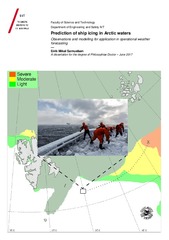Prediction of ship icing in Arctic waters - Observations and modelling for application in operational weather forecasting
Permanent link
https://hdl.handle.net/10037/11801View/
Thesis (PDF)
Paper I: Samuelsen, E.M., Løset, S. & Edvardsen, K.: Marine icing observed on KV Nordkapp during a cold air outbreak with a developing polar low in the Barents Sea. Available in Proceedings of the 23rd International Conference on Port and Ocean Engineering under Arctic Conditions, Norwegian University of Science and Technology, Trondheim, 2017, 1-14. (PDF)
Paper II: Samuelsen, E.M., Edvardsen, K. & Graversen, R.G.: Modelled and observed sea-spray icing in Arctic-Norwegian waters. Also available in Cold Regions Science and Technology 2017, 134:54-81. (PDF)
Date
2017-11-20Type
Doctoral thesisDoktorgradsavhandling
Author
Samuelsen, Eirik MikalAbstract
A ship travelling in sub-freezing conditions may encounter sea spray, rain, fog or snow freezing onto various parts of it. Such ship icing is a well-known threat for those individuals who have served on ships operating in a cold marine climate. As de-icing techniques may be energy consuming, accurate prediction of icing is also desirable from a financial point of view. Throughout the last 60 years there have been several efforts trying to model this elusive phenomenon. However, the lack of accurate field observations poses questions to the accuracy of the state-of-the-art modelling approaches including the parameterization of the physical processes of the models. As a consequence, the current study presents and utilises icing data obtained from ship observations in Arctic-Norwegian waters supplemented with high-resolution reanalysis data. On the basis of a unique data set derived from observations recorded on a particular ship type of the Norwegian Coast Guard, a completely new icing model has been developed. Verification of this Marine Icing model for the Norwegian COast Guard (MINCOG) and comparison to currently-applied methods in operational weather forecasting, reveals higher accuracy of MINCOG compared to the other methods. Furthermore, the study stresses the importance of including wave information separately into marine-icing models rather than incorporating it in the wind-speed parameter. A major finding of the study is that nature dictates an upper limit to the degree of icing that may arise from wave-ship interactions, since high waves and very low air temperatures rarely coexist. It is also highlighted that the inclusion of snow may be important for ship icing to transpire, and that icing ensues most frequently during cold-air outbreaks from the ice. In addition, when a more general approach is applied to the icing problem, a prediction method utilising the temperature at 850 hPa provides a potential for forecasting icing several days or weeks ahead in time. The prediction models presented in this study may be incorporated in an ensemble prediction system (EPS) providing the officer of a ship an early warning about the risk of icing and the probability of an expected growth rate of icing. Et skip som beveger seg i omgivelser med temperaturer under 0 grader, kan oppleve at sjøsprøyt, regn, tåke eller snø fryser på ulike deler av skipet. Slik skipsising er en velkjent trussel for de som har jobbet på skip som opererer i et kaldt maritimt klima. Siden avising kan være energikrevende, er nøyaktig isingsvarsling
ønskelig også fra et økonomisk ståsted. I løpet av de siste 60 årene har det vært mange forsøk på å modellere dette kompliserte fenomenet, men mangelen på gode feltobservasjoner gjør at man må stille spørsmål ved nøyaktigheten til dagens modelleringsmetoder inkludert parameteriseringen av modellenes fysiske prosesser. Som en følge av dette presenterer og anvender dette studiet isingsdata fremkommet
av skipsobservasjoner fra Arktisk-Norske farvann. Med utgangspunkt i et unikt datasett utledet av observasjoner utført på en bestemt skipstype fra Den norske Kystvakt, har en helt ny isingsmodell blitt utviklet. Verifikasjon av denne maritime isingsmodellen for Den norske Kystvakt (MINCOG), og sammenligning med andre metoder brukt i operasjonell værvarsling, avslører at MINCOG verifiserer
bedre enn de andre metodene. Videre understreker studien viktigheten av å inkludere bølgeinformasjon separat i isingsmodeller brukt over sjø, og ikke inkludert som en del av vindstyrken. Et hovedfunn i studien er at naturen setter en øvre begrensning for mengden ising som kan oppstå på grunn av bølge-skip interaksjoner fordi høye bølger og veldig lave lufttemperaturer sjeldent opptrer samtidig eller i
de samme områdene. Det er også fremhevet at snø kan være en viktig faktor for at ising skal kunne forekomme, og at ising oppstår hyppigst i forbindelse med kaldluftsutbrudd fra isen. Hvis man bruker en overordnet tilnærming til isingsproblematikken, vil en prediksjonsmetode som utnytter temperaturen i 850 hPa, gi et potensiale for å varsle ising dager eller uker framover i tid. Prediksjonsmodellene som presenteres i studien kan bli inkludert i et ensemblevarslingssystem (EPS) som kan gi en skipsoffiser et tidlig forvarsel om risikoen for ising og en sannsynlighet for forventet isingshastighet.
Description
The papers III and IV of this thesis are not available in Munin.
Paper III: Samuelsen, E.M.: Ship-icing prediction methods applied in operational weather forecasting. (Manuscript). Published version in Quartelrly Journal of the Royal Meteorological Society, 144(710), 13-33, is available at http://dx.doi.org/10.1002/qj.3174.
Paper IV: Samuelsen, E.M. & Graversen, R.G.: Weather situation during observed ship-icing events off the coast of Northern Norway and the Svalbard archipelago. (Manuscript). Published version in Weather and Climate Extremes, is available at https://doi.org/10.1016/j.wace.2019.100200.
Publisher
UiT Norges arktiske universitetUiT The Arctic University of Norway
Metadata
Show full item recordCollections
Copyright 2017 The Author(s)
The following license file are associated with this item:


 English
English norsk
norsk
